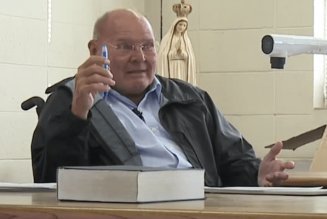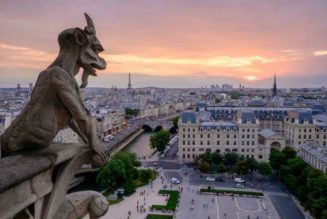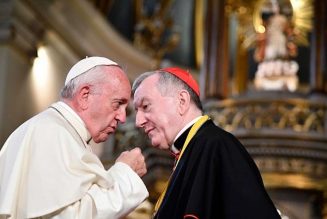ROME – Over my years in Rome, I’ve often mused on something St. John Paul II liked to tell people who live and study here: Imparare Roma!, meaning “learn Rome!”, with the idea being that just walking around the city offers a unique education in Catholicism, both its glories and its grubbiness.
John Paul knew what he was talking about, having studied here in the late 1940s at the Dominican-run Angelicum University, spending considerable time in Rome during the Second Vatican Council (1962-65), and, of course, serving for almost 27 years as Bishop of Rome.
I’ve always found his maxim about “learning Rome” to be true, and a recent move across town brought home the point anew.
Before my wife and I married in January, we both had apartments near the Vatican. Afterwards, we found a new place across the Tiber River in the city center. On a map that’s a relocation of only about two and a half miles, but historically and culturally it meant we moved about eight centuries and from one side of a defining historic rivalry to the other.
Our old neighborhood was papal Rome. The main street running through it is named for Pope Gregory VII, who reigned in the 10th century and is best known for staring down the monarchs of Europe during the Investiture Controversy. Most of the streets radiating off it are named for popes, cardinals and ecclesiastics who governed Rome as secular rulers for centuries.
Our new setting is definitely, and defiantly, Republican Rome, meaning it’s the past as seen through the eyes of the side that fought to bring down that very papal rule.
We’re in a large swath of the city called “Prati,” which comes from the ancient Roman term Prata Neronis, or “Fields of Nero.” For most of its history, Prati was a sprawling mass of vineyards, cane fields, orchards and small swamps. It began taking its present form only after the Fall of Rome of 1870, which marked the definitive end of the Papal States and the birth of a unified Republic of Italy.
Although Cavour, one of the architects of Italian unification, had envisioned a “free Church in a free State,” the pope at the time, Pius IX, refused to accept the authority of the new regime and declared himself a “Prisoner of the Vatican.” Anti-clerical forces on the Republican left gained leverage from the pope’s intransigence, and Prati was their great experiment in urban planning.
Notoriously, all the streets of the area are designed so that none of them have a view of the cupola of St. Peter’s Basilica at the end.
Our little neighborhood is called “Della Vittoria” (commemorating Italy’s victory in World War I, when it entered on the side of the Central Powers but switched to the Allies). The heart of the neighborhood is the “Piazza Mazzini,” named for Giuseppe Mazzini, an 19th century Italian patriot and revolutionary who was the leader of a triumvirate that governed Rome during the short-lived Republic of 1849, until French troops called in by Pius IX drove Mazzini into exile.
Mazzini continued to campaign for unification and independence, living to see it before he died in 1872. Though he described himself as a champion of “humanitarian Catholicism,” he was a bitter critic of the Vatican and the papacy. After Pius IX published an encyclical letter in 1849 calling the project to end the Papal States “diabolical,” which was written in Naples where he had taken temporary refugee waiting for the insurrection to be crushed, Mazzini penned a scathing reply. Here’s how it opens:
“The words of Pius IX don’t come from Rome. Would you say it’s as if he knew he couldn’t speak this anathema to freedom, this condemnation of the education of mankind, which is the continuous tradition of the law and the life of God on earth, from the city that initiated two great eras of progress for humanity, this city of eternal traditions and love? His words, dictated by the side of the worst kings of Italy, are the words of a man who trembles and curses. The divorce between him and the world, between the community of believers which is the true Church and the fornicating aristocracy that usurps its name, is sculpted into every syllable.”
That’s the guy who’s the hero of our new neighborhood.
The four streets that surround our building are named, respectively, for a politician and military commander condemned to death by the Papal States for taking part in the 1849 uprising who escaped and continued to fight alongside Garibaldi; another general once deported to New Orleans for his role in anti-monarchical skirmishes in 1821, who later moved to New York and married an Irish immigrant, and who returned to Italy to fight on the Republican side in 1849 and again in 1870; and two women who were partisans of the brief-lived Republic of Naples in 1799, which is seen as a precursor of the Italian Risorgimento.
We’re literally surrounded, in other words, by erstwhile enemies of the pope.
With the passage of time, however, many Italians today who consider themselves heirs to Mazzini, who believe in a Democratic Italy with a humanizing mission in the world, see the papacy as a key ally rather than an enemy. I like to think there’s an architectural expression of that rapprochement in the fact that right across the street from our building, the soaring Basilica of the Sacred Heart of Christ the King (the cornerstone for which, by the way, was laid the same day John Paul II was born in 1920) stands cheek by jowl with the equally soaring Rome headquarters of RAI, the state broadcaster.
Meanwhile, the papacy now looks upon Garibaldi, Mazzini, Cavour and the rest as having done them a great historical favor. In 1970 St. Paul VI famously sent his Vicar of Rome, Cardinal Angelo Dell’Acqua, to take part in celebrations of the 100th anniversary of the Fall of Rome, calling it “providential” and saying it liberated the papacy to focus on its evangelical mission.
This lesson from Rome, therefore, is about perspective.
People who today seem enemies may later become friends; disputes that now seem intractable may dissolve; and ideas that seem anathema may come to be not only acceptable but eminently “orthodox.” There’s an elite school for future Vatican diplomats in Rome called the Accademia where they offer graduate seminars on this stuff, but truthfully, all we need to do to get the same education is to walk out our front door.
In sum, Rome is forever an invitation to patience. Admittedly, fostering patience in a Twitter-dominated world, where snap judgments and sweeping generalizations are rewarded far more than sobriety and restraint, is probably a long-term undertaking … but then, of course, Rome wasn’t built in a day either.
Follow John Allen on Twitter at @JohnLAllenJr.











